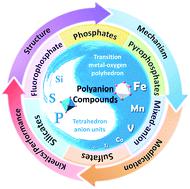当前位置:
X-MOL 学术
›
Chem. Soc. Rev.
›
论文详情
Our official English website, www.x-mol.net, welcomes your feedback! (Note: you will need to create a separate account there.)
Polyanion-type cathode materials for sodium-ion batteries.
Chemical Society Reviews ( IF 46.2 ) Pub Date : 2020-03-29 , DOI: 10.1039/c9cs00846b Ting Jin 1 , Huangxu Li , Kunjie Zhu , Peng-Fei Wang , Pei Liu , Lifang Jiao
Chemical Society Reviews ( IF 46.2 ) Pub Date : 2020-03-29 , DOI: 10.1039/c9cs00846b Ting Jin 1 , Huangxu Li , Kunjie Zhu , Peng-Fei Wang , Pei Liu , Lifang Jiao
Affiliation

|
Room-temperature sodium-ion batteries (SIBs) are regarded as promising candidates for smart grids and large-scale energy storage systems (EESs) due to their significant benefits of abundant and low-cost sodium resource. Among the previously reported cathode materials for SIBs, layered transition-metal oxides and polyanion-type materials are considered to be the most attractive options. Although many layered transition-metal oxides can provide high capacity due to their small molecular weight, their further application is hindered by low output voltage (mostly lower than 3.5 V), irreversible phase transition as well as storage instability. Comparatively, polyanion-type materials exhibit higher operating potentials due to the inductive effect of polyanion groups. Their robust 3D framework significantly decreases the structural variations during sodium ion de/intercalation. Moreover, the effect of strong X-O (X = S, P, Si, etc.) covalent bonds can effectively inhibit oxygen evolution. These advantages contribute to the superior cycle stability and high safety of polyanion-type materials. However, low electronic conductivity and limited capacity still restrict their further application. This review summarizes the recent progress of polyanion-type materials for SIBs, which include phosphates, fluorophosphates, pyrophosphates, mixed phosphates, sulfates, and silicates. We also discuss the remaining challenges and corresponding strategies for polyanion-type materials. We hope this review can provide some insights into the development of polyanionic materials.
中文翻译:

钠离子电池用聚阴离子型正极材料。
室温钠离子电池(SIB)被认为是智能电网和大规模储能系统(EES)的有希望的候选者,因为它们具有丰富而低成本的钠资源的显着优势。在先前报道的用于SIB的阴极材料中,层状过渡金属氧化物和聚阴离子型材料被认为是最有吸引力的选择。尽管许多层状过渡金属氧化物由于分子量小而可提供高容量,但其低电压输出(大多低于3.5 V),不可逆相变以及存储不稳定性阻碍了它们的进一步应用。相比之下,由于聚阴离子基团的感应作用,聚阴离子型材料显示出更高的工作电势。他们强大的3D框架大大减少了钠离子脱嵌过程中的结构变化。此外,强XO(X = S,P,Si等)共价键的作用可以有效抑制氧的释放。这些优点有助于聚阴离子型材料的优异循环稳定性和高安全性。但是,低电导率和有限的容量仍然限制了它们的进一步应用。这篇综述总结了用于SIB的聚阴离子型材料的最新进展,其中包括磷酸盐,氟磷酸盐,焦磷酸盐,混合磷酸盐,硫酸盐和硅酸盐。我们还将讨论聚阴离子型材料的剩余挑战和相应策略。我们希望本文能为聚阴离子材料的发展提供一些见识。强XO(X = S,P,Si等)共价键的作用可以有效抑制氧的释放。这些优点有助于聚阴离子型材料的优异循环稳定性和高安全性。但是,低电导率和有限的容量仍然限制了它们的进一步应用。这篇综述总结了用于SIB的聚阴离子型材料的最新进展,其中包括磷酸盐,氟磷酸盐,焦磷酸盐,混合磷酸盐,硫酸盐和硅酸盐。我们还将讨论聚阴离子型材料的剩余挑战和相应的策略。我们希望本文能为聚阴离子材料的发展提供一些见识。强XO(X = S,P,Si等)共价键的作用可以有效抑制氧的释放。这些优点有助于聚阴离子型材料的优异循环稳定性和高安全性。但是,低电导率和有限的容量仍然限制了它们的进一步应用。这篇综述总结了用于SIB的聚阴离子型材料的最新进展,其中包括磷酸盐,氟磷酸盐,焦磷酸盐,混合磷酸盐,硫酸盐和硅酸盐。我们还将讨论聚阴离子型材料的剩余挑战和相应的策略。我们希望本文能为聚阴离子材料的发展提供一些见识。这些优点有助于聚阴离子型材料的优异循环稳定性和高安全性。但是,低电导率和有限的容量仍然限制了它们的进一步应用。这篇综述总结了用于SIB的聚阴离子型材料的最新进展,其中包括磷酸盐,氟磷酸盐,焦磷酸盐,混合磷酸盐,硫酸盐和硅酸盐。我们还将讨论聚阴离子型材料的剩余挑战和相应的策略。我们希望本文能为聚阴离子材料的发展提供一些见识。这些优点有助于聚阴离子型材料的优异循环稳定性和高安全性。但是,低电导率和有限的容量仍然限制了它们的进一步应用。这篇综述总结了用于SIB的聚阴离子型材料的最新进展,其中包括磷酸盐,氟磷酸盐,焦磷酸盐,混合磷酸盐,硫酸盐和硅酸盐。我们还将讨论聚阴离子型材料的剩余挑战和相应策略。我们希望本文能为聚阴离子材料的发展提供一些见识。硫酸盐和硅酸盐。我们还将讨论聚阴离子型材料的剩余挑战和相应的策略。我们希望本文能为聚阴离子材料的发展提供一些见识。硫酸盐和硅酸盐。我们还将讨论聚阴离子型材料的剩余挑战和相应的策略。我们希望本文能为聚阴离子材料的发展提供一些见识。
更新日期:2020-03-29
中文翻译:

钠离子电池用聚阴离子型正极材料。
室温钠离子电池(SIB)被认为是智能电网和大规模储能系统(EES)的有希望的候选者,因为它们具有丰富而低成本的钠资源的显着优势。在先前报道的用于SIB的阴极材料中,层状过渡金属氧化物和聚阴离子型材料被认为是最有吸引力的选择。尽管许多层状过渡金属氧化物由于分子量小而可提供高容量,但其低电压输出(大多低于3.5 V),不可逆相变以及存储不稳定性阻碍了它们的进一步应用。相比之下,由于聚阴离子基团的感应作用,聚阴离子型材料显示出更高的工作电势。他们强大的3D框架大大减少了钠离子脱嵌过程中的结构变化。此外,强XO(X = S,P,Si等)共价键的作用可以有效抑制氧的释放。这些优点有助于聚阴离子型材料的优异循环稳定性和高安全性。但是,低电导率和有限的容量仍然限制了它们的进一步应用。这篇综述总结了用于SIB的聚阴离子型材料的最新进展,其中包括磷酸盐,氟磷酸盐,焦磷酸盐,混合磷酸盐,硫酸盐和硅酸盐。我们还将讨论聚阴离子型材料的剩余挑战和相应策略。我们希望本文能为聚阴离子材料的发展提供一些见识。强XO(X = S,P,Si等)共价键的作用可以有效抑制氧的释放。这些优点有助于聚阴离子型材料的优异循环稳定性和高安全性。但是,低电导率和有限的容量仍然限制了它们的进一步应用。这篇综述总结了用于SIB的聚阴离子型材料的最新进展,其中包括磷酸盐,氟磷酸盐,焦磷酸盐,混合磷酸盐,硫酸盐和硅酸盐。我们还将讨论聚阴离子型材料的剩余挑战和相应的策略。我们希望本文能为聚阴离子材料的发展提供一些见识。强XO(X = S,P,Si等)共价键的作用可以有效抑制氧的释放。这些优点有助于聚阴离子型材料的优异循环稳定性和高安全性。但是,低电导率和有限的容量仍然限制了它们的进一步应用。这篇综述总结了用于SIB的聚阴离子型材料的最新进展,其中包括磷酸盐,氟磷酸盐,焦磷酸盐,混合磷酸盐,硫酸盐和硅酸盐。我们还将讨论聚阴离子型材料的剩余挑战和相应的策略。我们希望本文能为聚阴离子材料的发展提供一些见识。这些优点有助于聚阴离子型材料的优异循环稳定性和高安全性。但是,低电导率和有限的容量仍然限制了它们的进一步应用。这篇综述总结了用于SIB的聚阴离子型材料的最新进展,其中包括磷酸盐,氟磷酸盐,焦磷酸盐,混合磷酸盐,硫酸盐和硅酸盐。我们还将讨论聚阴离子型材料的剩余挑战和相应的策略。我们希望本文能为聚阴离子材料的发展提供一些见识。这些优点有助于聚阴离子型材料的优异循环稳定性和高安全性。但是,低电导率和有限的容量仍然限制了它们的进一步应用。这篇综述总结了用于SIB的聚阴离子型材料的最新进展,其中包括磷酸盐,氟磷酸盐,焦磷酸盐,混合磷酸盐,硫酸盐和硅酸盐。我们还将讨论聚阴离子型材料的剩余挑战和相应策略。我们希望本文能为聚阴离子材料的发展提供一些见识。硫酸盐和硅酸盐。我们还将讨论聚阴离子型材料的剩余挑战和相应的策略。我们希望本文能为聚阴离子材料的发展提供一些见识。硫酸盐和硅酸盐。我们还将讨论聚阴离子型材料的剩余挑战和相应的策略。我们希望本文能为聚阴离子材料的发展提供一些见识。


























 京公网安备 11010802027423号
京公网安备 11010802027423号